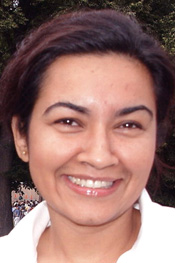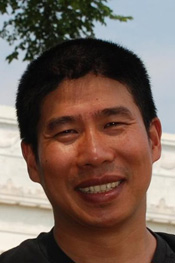Fathman Lab Alumni
 |
|
Swati Acharya, PhD
Position: Post Doctoral Fellow
Education:
Postdoctoral: Stanford University School of Medicine, Palo Alto, CA
Graduate: Tufts University School of Medicine, Boston, MA (PhD-Genetics)
Arizona State University, Tempe, AZ (M.S- Microbiology)
Andhra University, AP, India (M.S. – Applied Microbiology)
Undergraduate: Andhra University, AP, India (B.S. Chemistry)
Project: Tregs and Teffectors
 |
|
Pearl Chang
Position: Medical Student
Education:
Undergraduate: Stanford University, Class of 2004
Email:
 |
|
Guangyu Chen, PhD
Position: Visiting Research Associate
Education:
Project: Identification and characterization of CD86/CD80 binding partner in T effector cells and its biological mechanism in the suppressive immune response mediated by CTLA-4 / CD86 or CD80 pathway.Postdoctoral: Beijing Institute of Basic Medical Sciences, Beijing, China
Graduate: Beijing Institute of Pharmacology and Toxicology, Beijing, China
Undergraduate: B.S., Shandong University, Jinan, China
Email:
 |
|
Remi J Creusot, PhD
Position: Research Associate
Education:
Project: Pathogenesis of type I diabetes in the non-obese diabetic mouse model: mechanisms of peripheral tolerance that maintain insulitis into a non-invasive form and their failure during the transition from non-invasive to invasive/destructive insulitis; role of Deaf1 and stromal cells in enforcing peripheral tolerance; role of microRNAs in the pathogenesis of the disease. Cellular gene therapy of type I diabetes using dendritic cells modified by lentiviral transduction or mRNA electroporation to express immunoregulatory cytokines.Postdoctoral: Stanford University
Graduate: PhD Immunology, University College London, UK
Undergraduate: BS Biochemistry, MS Microbiology & Enzymology, University of Nancy, France
Email:
 |
|
Hongwu Du, PhD
Position: Visiting Research Associate
Education:
Project: I am attempting to set up a baseline immune profile of normal tissue samples at the single-cell level from PBCs harvested from normal individuals at different ages. It is important to know which immune system gene(s) change their expression with age. Using state of the art immune monitoring technology, and a step-by-step research protocol, it should be possible to define changes in immune profile as a function of age. This data set would serve as an important control for future studies of gene expression in disease states of older people.Postdoctoral: School of Medicine, Tsinghua University, Beijing, China
Graduate: Chinese Academy of Medical Sciences and Peking Union Medical College (CAMS&PUMC), Beijing, China
Undergraduate: Shandong University, Jinan, China
Email:
 |
|
Ana Paula Galvao da Silva, PhD
Position: Postdoctoral Fellow
Education:
Postdoctoral: Stanford University School of Medicine, Stanford, CA (since 2003)
Graduate: Immunology PhD, University of Sao Paulo, Sao Paulo, Brazil
Undergraduate: Biomedical Science, Federal University of Pernambuco, Brazil
Project:The suppressive role of sCD83 in a mouse model of diabetes; phenotype and mechanism of action studies. The hypothesis being addressed in this proposal is that a soluble form of the cell surface molecule CD83 will prevent or treat ongoing type 1 diabetes (T1D) in NOD mice based upon preliminary findings as well as previous work in other models.
The role of GRAIL in the induction of anergic and regulatory CD4+ T cells in the tumor microenvironment. GRAIL (RNF128) is a type 1 transmembrane RING E3 ubiquitin ligase that localizes to the transferrin-recycling endocytic pathway. While very little expression in resting CD4+ T cells is observed, GRAIL mRNA and protein becomes upregulated in T cells exposed to antigen in the absence of appropriate costimulation or following peptide administration in a tolerazing fashion in vivo. CD4+ T cells infiltrating tumor masses seem to become tolerant to the tumor and in certain cases may differentiate into Tregs, which may block the anti-tumor immune response. In most cases the differentiation into Tregs is due to the lack of appropriate co-stimulation and due to the presence of regulatory molecules that down-regulate T cell activation. Our goal is to demonstrate that antigen specific CD4+ TILs express GRAIL and become anergic and regulatory, and by blocking GRAILs effects, tumor immunity can be restored.
Email:
 |
|
Diana Gómez-Martín, MD, PhD
Position: Postdoctoral Scholar
Education:
Postgraduate: Stanford University
Graduate: MD, Facultad de Medicina, Universidad Nacional Autónoma de México (UNAM), Mexico city, Mexico.
MSc Immunology, Facultad de Medicina, Universidad Nacional Autónoma de México (UNAM), Mexico city, Mexico.
PhD Immunology, Facultad de Medicina, Universidad Nacional Autónoma de México (UNAM), Mexico city, Mexico.
Undergraduate: Brown University, B.S. Biology
Project: GRAIL and Autoimmun ity: Identification of novel GRAIL substrates and their role in the pathogenesis of autoimmune diseases, such as systemic lupus erythematosus. Evaluation of GRAIL and endosomal trafficking of substrates. Characterization of GRAIL epistatic regulators (i.e. otubain 1 and USP8) interaction and their role in T cell responsiveness.
 |
|
Hideyuki Iwai, MD/PhD
Position:Postdoctoral Scholar
Education:
Residency: Tokyo Medical and Dental University, Faculty of Medicine
Medical/Undergraduate: Tokyo Medical and Dental University, M.D., Faculty of Medicine
Graduate: Tokyo Medical and Dental University, Ph.D., Department of Medicine and Rheumatology
Project: I. Analysis of the effect
and mechanism of action of soluble CD83 as therapy for a mouse model
of inflammatory arthritis
II. Analysis of the mechanism of action of anti-CD3
antibody in NOD mice treatment
III. Analysis of MCC (Mutated in Colorectal Cancer
Gene) function
IV. Treatment of NOD mice with GRAIL transduced T
cells
Email:
 |
|
Yul Huh
Position: Graduate Student Researcher (M.S., Biological Sciences)
Education:
Undergraduate: Stanford University, B.S., Biological Sciences
Project: Characterization of novel anergy genes and their functionality in T cell activation and tumorigenesis.
Email:
 |
|
Keiichi Kodama, MD/PhD
Position: Postdoctoral Scholar
Education:
Residency: Keio University, School of Medicine
Medical: Gunma University, M.D., Faculty of Medicine
Graduate: Keio University, Ph.D., School of Medicine
Project: Road Map Study
Email:
 |
|
Jack Lin, PhD
Position: Postdoctoral Scholar
Education:
Graduate: Dartmouth Medical School, Ph.D. Microbiology & Immunology
Undergraduate: Brown University, B.S. Biology
Project: 1) The intersection of anergy genes and mTOR
signaling in directing T cell activation and differentiation
2) Examining the mechanism of action of mTOR-targeting small molecule
therapeutics and validation via RNA interference
3) Functional characterization of anergy-associated genes and their role
in T cell activation and T cell lymphoma/leukemia
4) Utilizing novel genome-wide expression profile microarray screens
on human lymphocytes and human lymphomas/leukemias to identify new targets
for immunotherapy
Email:
 |
|
Neil Lineberry, PhD
Position: Post-doctoral scholar
Education:
Graduate: Stanford University, PhD in Immunology
Undergraduate: University of Virginia, BA in Biology
Project: I am interested in understanding the mechanisms of immune tolerance that prevent detrimental activation of the immune system against self. Since nearly all cellular protein expression is regulated by the ubiquitin-proteasome system, I am focusing on how the E3 ligase activity of GRAIL utilizes protein degradation to modulate T cell development, activation, and homeostasis. Potential applications of these projects include a greater understanding of the molecular pathogenesis of autoimmunity and other scenarios involving a breakdown in immune tolerance, such as graft rejection.
Email:
 |
|
Claudia Sandoval Montes, Ph.D.
Position: Postdoctoral Scholar
Education:
Postdoctoral: Dept. Molecular Biomedicine, CINVESTAV-IPN, México City, Mexico, Ph.D. Molecular Biomedicine
Graduate: Dept. Molecular Biomedicine, CINVESTAV-IPN, México City, Mexico, M.Sc. Molecular Biomedicine
Undergraduate: Universidad Nacional Autónoma de México (UNAM), México City, México, B.Sc. Pharmacological and Biological Chemistry
Project :Understanding why CD4 tumor infiltrating lymphocytes (TILs) are unresponsive is the focus of my work. Have they been rendered anergic or have they been rendered unresponsive by Tregs? If the mechanism of CD4 TIL unresponsiveness can be characterized, there may be targets of opportunity for drug development. The ubiquitin E3 ligase, GRAIL, is involved in the induction and maintenance of anergy and regulation in CD4 T cells. I plan to characterize GRAIL, its epistatic regulators, Otubain-1 and USP8, and their interactions in generating and maintaining anergic/non-responsive CD4 TILs.
Email:
 |
|
Deqiao Sheng, PhD
Position: Postdoctoral fellow
Education:
Graduate: Chinese Academy of Medical Science & Peking Union Medical College, Ph.D. Molecular Biology
Undergraduate: Xiamen University, B.S. Biology
Project: RoadMap of NOD T1D
Email:
 |
|
Emilie Vinolo, PhD
Position: Postdoctoral Fellow
Education:
Graduate: Ph.D. in biochemistry from Universite Pierre et Marie Curie/Institut Pasteur, Paris (France)
Undergraduate: French engineering school E.S.P.C.I., Chemistry major
Project: From my PhD dissertation work on the NF-ΚB essential modulator (NEMO) protein, I became interested in exploring the interface between ubiquitination and signaling in the immune system. As a result, I joined the Fathman lab to focus on two projects. First, several bodies of evidence suggest a possible role for lymphocyte activation gene 3 (LAG-3) in the negative regulation of T cell activation and the induction and/or maintenance of tolerance. I am presently trying to identify proteins that interact with LAG-3 cytoplasmic domain in order to gain further insight into LAG-3 intracellular signaling and its regulation of T cell function. Second, I am utilizing a structure-function approach to refine the model in which expression of the E3 ligase GRAIL is regulated by two deubiquitinating enzymes, Otubain 1 and USP8 (see Soares L. et al. Nat. Immunol. 2004).
Email:
Home Page: http://www.linkedin.com/in/evinoloprofile

